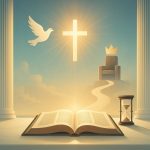| Host: | Douglas Clark |
|---|---|
| Guests: | Alden Thompson and Zdravko Stefanovic |
| Quarter: | Book of Amos |
| Lesson: | 8 |
| Sabbath: | November 24th, 2001 |
Background and Literary Considerations
- We are introduced in this lesson to “vision reports,” another in the vast repertoire of Amos’ speech forms. These appear throughout the Bible and are typically introduced in the Old Testament by some phrase like: “the Lord showed me” or “the hand of the Lord was upon me.” There follows then a report of what the prophet saw, sometimes with explanation. Isaiah, Ezekiel and Zechariah are famous for their vision reports, as are the apocalyptic books of Daniel and Revelation. Visions provide one of the means by which God communicated with his people and the reports, even if somewhat stylized at times, attempt to share what God passed along and how the prophet related to it. These are often interactive visions! Why this means of communication? Why not simply direct speech–from God to the people–so there would be no room for error or mis-communication? How does inspiration function with God’s use of visions which are reported to the people by other humans?
- In Amos we find five vision reports which occupy a good deal of chapters 7-9: 7:1-3; 7:4-6; 7:7-9; 8:1-3; and 9:1-4. As is clear, the reports are not long, only three or four verses each. However, don’t let their short size fool you; all of these pack a powerful punch, worthy of our serious reflection. Taken together, how do they connect and flow? Is there any kind or progression (or regression!) among the five? As they appear in the book, they were not to be taken in isolation from each other (as we will study them). What does it mean that they appear as they do? Especially in the book of Amos? Should we expect any surprises? Why the judgmental tone of all of them? Is there any hope? What happens to the possibility of hope as the vision reports move along?
Relevant Biblical Passages
- Amos 7:1-3 (Vision Report #1) – The subject of the first vision report is locusts. If ever a word struck terror into the hearts of people trying to make a living and put food on the table growing grain and olive trees and raising sheep and goats dependent on sufficient foliage, “LOCUSTS!” would get everyone’s attention! Why locusts as an instrument of judgment?
Checking a recent Bible commentary on these verses might add some dimensions to what we note in the following comments and questions. Who is responsible for the locust plague? What role does God play in the mind of the prophet in this judgmental cataclysm? Does God bring about hordes of locusts to destroy crops on which the people are dependent? Would he do that?! When do the locusts come–at the beginning of growth or at the end of the growing process, after all the work of tending, tilling, protecting against animal or human pests, hoping and praying that the blight and mildew would mercifully pass them by? And, why after the king has taken his taxes (“the king’s mowings”)? Wasn’t the king part of the problem of injustice? On whom does this judgment fall–the wicked, the rich, the poor farmers, everyone? Why?
On what is hope based in this vision report? Do we hear anything about whether the people repent? Or is it only based on the prophet’s intervention with God? (Prophets normally speak to the people on behalf of God and priests normally speak to God on behalf of the people; Amos has become priestly!) Or is it based on God’s repentance?! What does this mean? Does God do this?
Contributions to Study of Amos and the Bible
- The vision reports introduce another dimension to Amos’ preaching. Do they carry the same message as his other words and speech forms? Is he still concerned about the poor and oppressed in society?
Lessons for Life
- What does the message of God’s willingness to change his mind convey about God? About us and how we behave?





